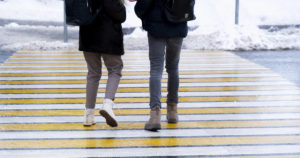Pedestrian Fatalities Skyrocket
February 15, 2021 Last year the Governor’s Highway Safety Administration (GHSA) predicted 6,590 pedestrian deaths resulting from motor vehicle crashes in 2019, which is the highest number of fatalities documented in 30 years. The agency was right, and there is no indication that the dangerous trend will reverse any time soon. In Philadelphia for example, the numbers continued to grow in 2020. In fact, they increased by a startling 88% and accounted for more than one-half of the total traffic-related fatalities for that same year. Similar reports have popped up across the country, with the American Automobile Association (AAA) reporting that some states have experienced increases in pedestrian fatalities as high as 90%.
Last year the Governor’s Highway Safety Administration (GHSA) predicted 6,590 pedestrian deaths resulting from motor vehicle crashes in 2019, which is the highest number of fatalities documented in 30 years. The agency was right, and there is no indication that the dangerous trend will reverse any time soon. In Philadelphia for example, the numbers continued to grow in 2020. In fact, they increased by a startling 88% and accounted for more than one-half of the total traffic-related fatalities for that same year. Similar reports have popped up across the country, with the American Automobile Association (AAA) reporting that some states have experienced increases in pedestrian fatalities as high as 90%.
We must all do our part to make an impact on reducing pedestrian injuries and fatalities. We must stay vigilant behind the wheel and pledge to drive responsibly so that at the end of the day, everyone gets home safe and sound.
Risk Factors
Pedestrians (in addition to motorcyclists and bicyclists) are considered as the “weak party” when a collision happens. This is because unlike motor vehicle drivers and passengers, pedestrians have little-to-no protective devices (such as seat belts, air bags, and the safety that the physical vehicle body itself provides) to absorb the impact of a crash. The AAA says a few main factors play a role in the rapid fatality growth, including:
- Vehicle size is increasing
- Growing population rates
- A greater number of people are living in urban areas
- More people choosing to walk as their mode of transportation
- Irresponsible and illegal driving behaviors, like driver distraction, driving under the influence of alcohol and/or drugs, aggressive driving, and speeding
Vehicle size is a big factor in pedestrian accidents. According to the GHSA, a pedestrian who is struck by an SUV is twice as likely to die as one who is struck by a passenger vehicle. The rate of pedestrian fatalities involving sport utility vehicles has also increased more quickly over the last decade than those that involve cars.
Driver Safety Tips
Because the majority of automobile accidents involving pedestrians occur at night and away from intersections, the GHSA says it is also important that states take steps to make pedestrians more visible to drivers. This involves installing features that would create safer roadway crossings, like clearly marked pedestrian crosswalks, traffic signals, and street lights. While changes need to occur on a national level in order to protect pedestrians from known hazards, there are also numerous steps that drivers can take to help pedestrians stay safe. Here are just a few examples from the National Highway Transportation Safety Administration, or NHTSA:
- Look out for pedestrians at all times
- Be particularly cautious when driving in inclement conditions or when there is poor visibility, like at nighttime or when it is raining, foggy, or snowing
- Always slow down and be prepared to come to a complete stop when you are approaching, turning through, or entering a crosswalk
- Give ample space to pedestrians in the crosswalk and always yield to them
- Never pass a vehicle that is stopped at a crosswalk
- Always be cautious when you are backing up
- Observe the posted speed limit, particularly when there are people on the street or when you are in school zones or neighborhoods where children are typically at play
Age also plays a role in pedestrian accidents. On average, pedestrians who are 65-years-old and above account for approximately 20% of annual pedestrian fatalities. The NHTSA estimates that one in every five children under the age of 15 that dies in a traffic accident is a pedestrian. Parents and caregivers should take time to teach children the importance of being alert when they are walking and especially when they are crossing the street. The NHTSA recommends telling children to always:
- Stop at the curb or the edge of the road if there is no curb
- While stopped, look left, right, and then left again for moving cars before stepping into the street
- If you do see a car, wait for it to go by. Then look left, right, and left again before attempting to cross
- If there is a parked car where you are trying to cross, check to make sure that it is not running and that there is no driver behind the wheel
- If it is not running and there is no driver, walk to the edge of the car and look left, right, and then left again before entering the street
- Only once no cars are coming should you walk – never run – across the street. Continue to keep an eye out for cars while you are crossing
For other tips on how to talk to kids and teens about and pedestrian safety, please visit: https://www.nhtsa.gov/sites/nhtsa.dot.gov/files/811026.pdf.
If you are a pedestrian who was struck by a driver and you would like to explore what legal options you may have to file a personal injury automobile accident claim, someone at our firm can help. Contact a representative online now.
Philadelphia Personal Injury Lawyers at Galfand Berger, LLP Representing Automobile Accident Victims Since 1947
With offices located in Philadelphia, Bethlehem, Reading and Lancaster, Galfand Berger LLP serves clients throughout Pennsylvania and New Jersey. To schedule a consultation, call us at 800-222-8792 or complete our online contact form.
 Google Screened
Google Screened
